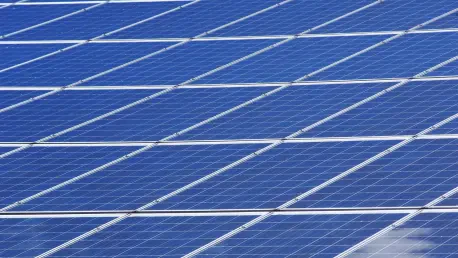In the rapidly evolving landscape of renewable energy, a pivotal breakthrough in solar power technology is set to redefine industry standards and sustainability metrics. Photovoltaic panels, specifically lead halide perovskite solar cells, have captured significant attention due to their high efficiency in converting sunlight into electricity. However, their potential has been overshadowed by critical hurdles, including environmental instability and lead’s toxic properties. Addressing these issues, researchers from the Autonomous University of Querétaro in Mexico have embarked on an innovative journey. They explore the realm of chalcogenide perovskites, presenting a compelling alternative that promises to mitigate lead concerns while enhancing performance and longevity. This paradigm shift not only accelerates the pursuit of cleaner energy systems but is poised to offer substantial economic and ecological benefits on a global scale.
The Role of Chalcogenide Perovskites in Solar Technology
Embracing the Need for Efficiency and Stability
Chalcogenide perovskites have emerged as revolutionary substitutes for traditional lead-based solar cells, primarily by addressing challenges in efficiency and stability. For years, these features have been critically evaluated, often finding lead-based cells susceptible to phase degradation over time. This ongoing instability translates into reduced lifespan and compromised performance in real-world applications. Chalcogenides stand out due to their robust composition, which inherently resists phase changes, ensuring operational consistency once deployed. By offering sustained efficacy, this innovative material promises to bridge the gap between laboratory success and commercial viability, aligning with the global impetus for sustainable development and eco-friendly practices.
Moreover, the research spearheaded by the Autonomous University of Querétaro underscores the necessity for safe and long-lasting solar solutions. Conducting 1,627 simulations, the study meticulously compared the performance metrics of chalcogenides against their lead counterparts. Published findings in the prestigious journal ‘Solar Energy Materials and Solar Cells’ highlighted significant enhancements in conversion efficiencies, marking a profound leap forward in solar technology. Such advances could substantiate claims of chalcogenide cells being a keystone in renewable energy systems, prompting further innovations and deployment strategies in diverse climatic conditions.
Implications for Lead Toxicity and Environmental Sustainability
The toxic nature of lead halide perovskite cells has long been a deterrent for widespread adoption in renewable energy systems. As governmental bodies and private organizations increasingly prioritize environmental standards, the reliance on toxic materials becomes less tenable. Chalcogenide perovskites offer a compelling alternative by completely eliminating lead. By doing so, the development aligns sharply with ecological mandates, paving the way for non-toxic production processes. This strategic transition not only meets the immediate need for safer materials but also promises to reduce manufacturing and disposal-related environmental impacts, promoting a sustainable lifecycle for solar technologies.
The clean energy narrative is closely tied to economic and environmental benefits, both of which are crucial for driving policy and investment. With the elimination of lead, these solar panels could significantly flatten carbon footprints across installation projects, marking a definitive step towards carbon neutrality. Furthermore, this progressive shift in material choice emphasizes a broader trend within the industry: the ongoing pursuit of maintaining high performance without compromising ecological integrity. Through such innovation, chalcogenides could redefine stakeholder discussions around solar energy, aligning product development with comprehensive sustainability goals while fostering public trust in renewable technologies.
Future Prospects and the Path Ahead
Innovation and Global Adoption
The global trend toward clean energy solutions is consistently demanding more efficient, less toxic alternatives, propelling researchers to explore novel materials like chalcogenides. As markets keenly await scalable applications of these lead-free alternatives, continuous research will likely drive technological advancements that refine production techniques and reduce cost barriers further. The potential for chalcogenide-based solar cells goes beyond technical merit; it represents a shift in paradigm, encouraging manufacturers to diversify portfolios and innovate within sustainability frameworks. Buy-in from policymakers and energy companies could catalyze mass production, amplifying energy accessibility worldwide and setting new benchmarks for renewable infrastructure.
The industry stands at a crossroads, where key decisions can accelerate progress toward globally significant energy goals. As technology progresses, these developments bolster competitive market positions, challenging stakeholders to optimize resources and adapt to evolving consumer expectations. Continuous exploration and collaboration between academia, industry experts, and environmental proponents will be paramount. In envisioning widespread adoption, the importance of addressing logistical challenges—such as production scale, material sourcing, and framework adaptation—cannot be overstated, each playing a pivotal role in effectively transitioning from innovation to mainstream implementation.
Towards a Sustainable Solar Future
Chalcogenide perovskites are emerging as groundbreaking alternatives to traditional lead-based solar cells, specifically tackling issues of efficiency and stability. For years, concerns have been raised over lead-based cells’ susceptibility to phase degradation, which leads to reduced lifespans and compromised performance. Chalcogenides, however, excel with their strong composition that naturally resists phase changes, ensuring consistent operation after being deployed. This innovative material promises sustained effectiveness, bridging the gap between lab success and commercial practicality, aligning with global efforts toward sustainability and eco-friendly practices.
The Autonomous University of Querétaro has been pivotal in advancing safe and long-lasting solar solutions. Their study, involving 1,627 simulations, meticulously compared chalcogenides to lead counterparts, showcasing noteworthy boosts in conversion efficiencies in the journal ‘Solar Energy Materials and Solar Cells.’ Such breakthroughs could solidify chalcogenide cells as central to renewable energy, encouraging further innovations and deployment in varied climates.









